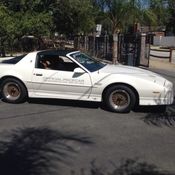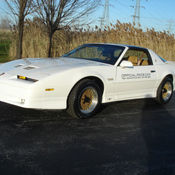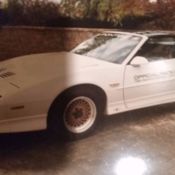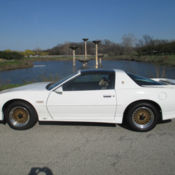1980 Pontiac Trans Am 20th Anniversary Turbo Pace Car
1980 Pontiac Trans Am Turbo Pace Car for sale in Highland, Michigan, United States
| Item location: |
Highland, Michigan, United States |
| Make: |
Pontiac |
| Model: |
Trans Am |
| SubModel: |
Turbo Pace Car |
| Trim: |
Red/Black |
| Year: |
1980 |
| Mileage: |
79,360 |
| VIN: |
2X87TAN136693 |
| Color: |
White |
| Power options: |
Air Conditioning |
| Fuel: |
Gasoline |
| Transmission: |
Automatic |
| Drive type: |
4.9L V-8 engine |
| Interior color: |
Black/Red |
| Options: |
T-Top |
| Vehicle Title: |
Clear |
| Want to buy? |
Contact seller!
|
Description for Pontiac Trans Am 1980
1980 Pontiac Trans Am 20th Anniversary Turbo Pace Car This Trans Am Pace car is a rare must see. Included with the sale of the Pace Car is: · Ricaro racing interior - red and black · Extra set of interior seats · Extra set of smoke T-Tops (in case) · Extra set of original decals · Extra set of tires/wheels · Odometer: 79. 60 Please read below for the specifics and history of this 1980 Pontiac Trans Am Pace Car. The Turbo Pace Car was built to commemorate the first time one car paced both the Indy 500 and the Daytona 500 in the same year. In what has become a popular move. Pontiac produced only 5700 Turbo Trans Am Indy 500 Pace car replicas complete with stickers and decals to make it look just like the real thing. The 80 Indy Trans Am was one of the LEAST modified cars EVER to pace the Indy 500. a turbocharged 4. 9L V-8 engine. the Turbo-Trans Am needed only minor modifications to bring it up to pace car specs. The Indy 500 Pace Car replicas. because of the standard 4. 9L turbocharged engine. were excluded from sales in California due to the emission requirements. Pontiac laid claim upon announcing the Pace Car Replica that this car was the first and only production car with a Turbocharged V8 as standard equipment. Interior Interior - Features This car has specially designed Ricaro racing interior. which is red and black. There is an extra set of seats that were finished in a combination of Doeskin vinyl and Hobnail cloth in the hue of oyster in excellent condition (original factory installed interior). In the center of the rear seat back. a Firebird logo was stitched into the trim. with the logo also being stitched into each door panel. Interior - Gauges All the stock gauges are fully functional and there are options like A/C and an automatic transmission. so you have a nice dose of luxury to go with your sport. Exterior T-top panels (smoke) and aluminum white "air-flow" wheels. An additional spare tire is mounted on racing wheel to match the other four. Graphics / Decals With a great look. awesome graphics package and a futuristic interior. the Turbo Trans Am's have rightfully taken their place among the great muscle cars of history. With a high-tech look that still seems right today. the white paint with charcoal accent color extending from the hood through the door upper. into the front of the sail panel. and through the forward half of the roof is a great way to make a high-profile statement without resorting to loud colors. A complete set of special decals were installed on the car. The hood bird was an exaggeration for the optional new for 1980 Turbo hood bird with the wing tips stretching to nearly the front fenders. The bird was larger than normal and made up of red. charcoal. and gray colors. Outside. the car was painted in a similar style to the 10th Anniversary Trans Am. with white replacing the silver complemented with gray accents. The "Turbo" cast aluminum wheels were painted white to match the exterior and had many areas machined away exposing the natural aluminum as had been common practice on the "Snowflakes". The exterior mirrors were painted gray and were given a dual black/red pinstripe which also followed many of the detail lines on the car. Hood Turbo Indy Pace Cars. coded X87. made their debut in 1980 with an asymmetrical hood and specially-designed hood graphics. Notes Pontiac. "We wanted to show that form follows function on this car. " The turbo 301 introduced the "turbo hood". making these the first Trans Am's since '69 to not have a shaker hood. The hood had about a 22 inch bulge that extended upwards 1 and 1/4 inches that was off set to the left of the hood centerline. Clearance for the relocated carburetor and plumbing from the turbocharger necessitated this bulge (much as the planned 2-4bbl's on the '70 T/A resultant shaker). Underneath. a hood blanket (the first such application on the Trans Am) had an aluminized shield over the turbocharger area to keep the hood paint from blistering. Under the Hood Under the hood is a turbocharged 301 V8 with 236-hp and 345 lb-ft of torque. and like the rest of the car has been untouched. Maintenance was done on the vehicle from 1980 all the way to 2011. The turbocharger chosen to "boost" the power of the 301 was the same Garrett TB305 unit which was in service in the Buick and Ford turbo engines. The turbocharger plumbing utilized a "draw through" design. where the boost took place behind the carburetor. Although. at best. this was compromised because the turbocharger did not get to work to its fullest potential. As the turbocharger comes up to higher speed. the turbo's boost is controlled to 9 PSI so the turbo doesn't overboost/detonate the engine. The compression ratio on the turbo is 7. 5:1. the horsepower is 210 at 4. 00 rpm. and the torque is 345ft. /lbs. at 2. 00rpm. But these were the days before fuel injection and GM could not risk the possibility if a forced induction fuel leak. Compared to the other turbos on the market. the T/A motor lacked most of the whine associated with turbocharged engines. Pontiac asked Garrett to provide better balanced turbo impellers to reduce the noise. The idea was to make the turbo as transparent as possible. to use the feel of the acceleration rather than the noise of the turbo to let the customers experience the power at hand. To prove the Turbo Trans Am's viability as a big engine replacement. the 1980 Indianapolis 500 would be paced by the first time in history by a Firebird. Eager to showcase the little turbo's ability. the engine and drive train would be stock. (but most likely blueprinted). The changes were limited to a rear axle ratio swap. utilizing a 2. 56:1 versus the standard 3. 08:1 gearing. and a larger P245/60R15 Goodyear Eagle GT tire. The taller gearing allowed the engine to operate in the 3500-4000 rpm range rather than 45-5000 rpm. exhibiting much less stress at the continual high speeds the pace car would be operated at. Pontiac built five cars for the track and the actual Pace Cars were built without air conditioning. This vehicle is being sold as is. where is. with no warranty expressed. written. or implied. I have represented the car to the best of my ability and shall not be responsible for the correct description or defects herein. and make no warranty in connection therewith. I cannot guarantee any part as being authentic. original or correct. or the mechanical condition of any part. There is no set-aside for defects and all sales are final. Any descriptions or representations are for informational and identification purposes only and is not to be construed as a warranty of any type. It is the responsibility of the buyer to have thoroughly inspected the vehicle and to have satisfied him or herself as to the condition and value and to bid based upon your judgment. I have and will make every reasonable effort to disclose any known defects associated with this vehicle prior to the close of sale. I assume no responsibility for any repairs regardless of any oral or written statements about the vehicle. The terms of sale shall be governed by and construed in accordance with the laws of the State of Michigan without regard to any conflict of laws or provisions thereof that might indicate the applicability of laws of any other jurisdiction. The venue for all legal proceedings shall be in Oakland Country. Michigan.
Other classic cars for sale
 Pontiac Turbo Trans Am Pace Car 20th Anniversary !!
Pontiac Turbo Trans Am Pace Car 20th Anniversary !!
 1989 Pontiac Trans Am GTA Turbo Indy Pace Car 20th Anniversary
1989 Pontiac Trans Am GTA Turbo Indy Pace Car 20th Anniversary
 1989 Pontiac 20th Anniversary Turbo Trans Am Indy Pace Car
1989 Pontiac 20th Anniversary Turbo Trans Am Indy Pace Car
 20TH ANNIVERSARY 1989 PONTIAC TURBO TRANS AM INDIANAPOLIS 500 PACE CAR
20TH ANNIVERSARY 1989 PONTIAC TURBO TRANS AM INDIANAPOLIS 500 PACE CAR
 1989 PONTIAC FIREBIRD TURBO TRANS AM SE 20TH ANNIVERSARY INDY 500 PACE CAR
1989 PONTIAC FIREBIRD TURBO TRANS AM SE 20TH ANNIVERSARY INDY 500 PACE CAR
 1989 Pontiac Trans Am Turbo 20th Anniversary Edition Indy 500 Pace Car
1989 Pontiac Trans Am Turbo 20th Anniversary Edition Indy 500 Pace Car
 1989 Pontiac 20th Anniversary Turbo Trans Am Pace Car Modified Wicked!!!
1989 Pontiac 20th Anniversary Turbo Trans Am Pace Car Modified Wicked!!!